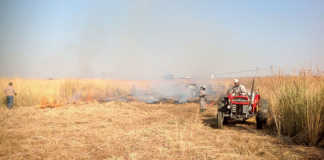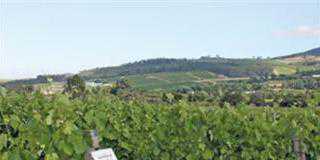South African farmers can reduce their expenditure on energy significantly by using stored solar energy for processing. This simple technology operates at night on sunlight energy stored by day. Using stored solar energy, Alkmaar Valley Macadamias saved 85% on its heat energy bill during the 2014 season, having obtained only a fraction of the energy required for its processing operation directly from Eskom.
Company structure
Alkmaar Valley Macadamias is a member of the Valley Macadamia Group, the umbrella group for three macadamia producers – Alkmaar, Sabie and Levubu Valley Macadamias Drying and Processing. It operates a new and highly efficient solar-assisted macadamia curing, processing and packaging plant on Inkuba Estate at Alkmaar near Nelspruit, Mpumalanga.
The plant has been designed as a 6 000t/year curing system to dry wet-in-shell (WIS) macadamia nuts from all over South Africa down to a kernel moisture content of 2% for the Asian market. Implementation has been in two phases. The first, with a processing capacity of 3 000t/year, went into production in mid-March 2014 and demonstrated the feasibility and major economic benefits of this system. Construction of the second phase will start in 2015 and the plant will be operational the following year.
Managing the Flow
Two mass hopper scales of 5t and 10t capacity respectively weigh the received WIS macadamia nuts before they are conveyed to an in-line steriliser en route to the curing bins. A 20kg nut sample of sterilised nuts, mechanically and randomly selected from the conveyor, is laboratory-tested for moisture content and quality to establish the client payout.
The nuts then go to one of two 100t-capacity curing rooms in either 5t (10-bin) or 10t (20-bin) batches. Curing time achieves complete curing, reducing the kernel moisture content from 18% down to 2%. This is equivalent to a moisture content of approximately 5,5% nut-in- shell (NIS) within 10 days.
After curing, the dry- in-shell (DIS) nuts are conveyed to a 5t weighing hopper and from there onto a quality sorting conveyor before passing through one of two rotating tumblers that size them according to the client’s specifications. The nuts are then weighed, bagged and tagged in 25kg sacks and shipped by container to their destination.
Principles governing the system design
- Preserving quality
Harvest quality must be preserved during the dehydration (curing) process. This is a low temperature process – at between 25°C and 35°C – at an optimum air speed designed to achieve consistent dehydration times and accurate, uniform final moisture content (MC) of the NIS.
- Low operational cost
The energy source must be as environmentally sustainable (‘green’) as practicably possible. Electricity use must be limited and highly cost-efficient as far as possible, powering only essential processing equipment.
- Low capital investment
The capital equipment must comply with design parameters and be fully utilised during the season. This eliminates over-designed transformers, switch gear, cable sizes and ostentatious buildings. It implies purpose-designed machines, handling equipment and controls, and consistent production processing times.
- Easy management and maintenance
Operator input and programmable logic computer (PLC) supervisory control and data acquisition (SCADA) controls must be user-friendly, with attention to the quality of macadamia processing without the distraction of labour requirements and maintenance of ancillary equipment and functions normally associated with boilers.
The concept
The Alkmaar Valley Macadamias processing plant’s purpose-designed and highly efficient solar-assisted curing system does away with a conventional fuel-fired boiler and the costs and management associated with it. These include labour, maintenance, fuel and ash handling, additional infrastructure and electricity.
A 400m² section of the factory roof, painted black, heats up in the sun during the day. Air under differential control transfers 90% of the gathered heat to a ‘top hat’ solar heat store. The latter consists of 540t of 17kg concrete breeze blocks, precisely stacked in a 300m³ room insulated with Chromadek cladding. The curing system directly uses the balance (10%) of the solar heat for processing during the daylight hours.
The PLC that controls a fully equipped SCADA installation manages the curing system and heat store. This enables automatic hysteresis control of all operations, but allows operator override if needed. The Bungay method used for curing enables efficient system heat management and precise equilibrium moisture content (EMC) control of the process air, ensuring accurate moisture content of DIS nuts.
The heat store operates at 25°C to 30°C, depending on prevailing weather conditions. The lowest ambient temperature, 2°C, was recorded in July. The system was designed for a theoretical storage capacity of 2 500HU, but once peaked at almost 2 700HU in July.
Most of the heat energy gathered in the ceiling space and stored in the heat store in a nine-hour solar day is redirected to the curing system’s air inlet during the following 15 non-solar (night time or heavily clouded) hours of a typical day.
During the 2014 season, sunlight provided approximately 85% of the total heat required for curing, with electric heating elements providing the balance of 15%.
The Eskom electrical heating cost for curing during the 2014 season was less than R0,05/ kg DIS at 2% MC. The electrical energy used for heating and other essential electrical components such as motors, conveyors, fans, air conditioners, lighting and computers was split into approximately 45% (heat) and 55% (other). The capital cost of the heat store is expected to be recovered within two seasons.
Designed for efficiency
The curing system/ heat store combination at Alkmaar Valley Macadamias has crucial design features:
About 15% of the solar heat gathered in the ceiling is used for daytime curing, with the balance (85%) being used at night.
PLC differential temperature monitoring accurately and timeously switches the curing process from the daytime solar ambient to the heat store in the late afternoon and back again the next morning.
Time of use (TOU) electrical tariff monitoring and automatic (operator-selected) control limits the peak time electricity use to a maximum of 25 hours per seven-day week.
Operator selection between automatic ‘fixed’ and ‘floating’ temperature control manages the rate and cost of drying. The ‘fixed’ temperature input varies from 32°C to 36°C. The ‘floating’ maximum and minimum temperature inputs are set at 38°C and 24°C respectively, with an average of between 29°C and 31°C.
Operator-selectable parameters set the conditions required for either automatic or ‘bin dry’ monitoring and control.
PLC monitoring records an unlimited graphic history of the condition in each drying room, all the heat store conditions, the history of power use in each of the major banks of heating elements, total Eskom power use of the plant, and peak electricity demand of the plant.
Electricity use in the plant is ring-fenced from other electricity uses, and the data will be used to establish the size of the future back-up generator. Eskom provides three- phase power on the TOU tariff ‘Ruraflex’ via a 150kVA supply (225A). Peak power demand never exceeded 75kVA during the 2014 season.
The person responsible for system alarm and failure management receives SMS notification of such incidents.
The capital cost of the heat store was about 60% of that of a shell-fired boiler. It is expected to be repaid within 18 operating months, with negligible future maintenance requirements.
The 2014 Eskom bill reflects a peak transformer load factor of almost 30% in May. At this factor, the Eskom administration cost is unavoidable at approximately 35% of the total monthly bill.
Future developments
The evaluation of the performance of the curing process using stored solar heat energy found that it has met all expectations. Refining the system will further improve its efficiency in the 2015 season. This implies modifications to further reduce dependency on Eskom power and will focus on controlling unwanted air losses, increasing the size of the heat-capture area on the roof and possibly using a high co-efficient of performance heat pump for additional heat storage at very low cost. The pump concept can also provide additional heat using a generator during an extended power failure.
New system
A second and similar system is currently being built near Levubu in Limpopo. It will have a processing capacity of 600t/year and come into operation in mid-March 2015.
Phone Roelof van Rooyen on 013 751 3475 or email [email protected].













